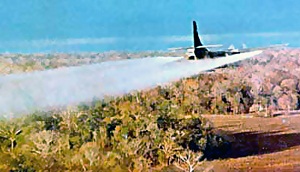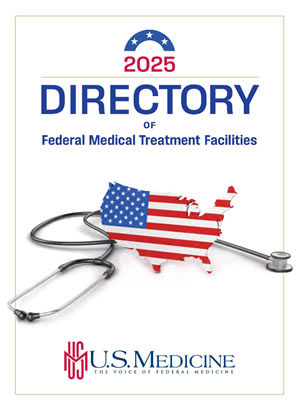Researchers Suggested Toxic Exposures Could Be Cause
BETHESDA, MD — While the incidence rates of soft-tissue sarcomas are lower in young U.S. active-duty military servicemen compared with those in the general population, according to a new study, those are higher in middle-aged servicemen, possibly because of greater cumulative exposure to toxins.
Soft-tissue sarcoma—cancers in muscle, fat, blood vessels, nerves and tendons—are rare and usually arise sporadically, although a small subset arise from exposure to radiation or other environmental factors, according to the report in Cancer.1
Because military personnel tend to experience more frequent and greater exposure to such environmental risk factors, the researchers sought to compare incidence rates of soft-tissue sarcomas between active-duty U.S. servicemen and men in the general U.S. population. Their goal was to assess whether the occurrence of soft-tissue sarcoma differed, which would provide a starting point for future research on related factors.
Because of a small numbers of active servicewomen in the dataset for further analysis, a comparable evaluation could not be accurately performed in women, the study team noted.
“Our study is descriptive, hoping to provide clues for analytical studies on factors associated with the differences between the military and general populations,” said senior author Kangmin Zhu, MD, PhD, of the Uniformed Services University of the Health Sciences. “Further descriptive research with more recent data containing a larger number of military patients is warranted.”
Background information in the article pointed out that soft-tissue sarcoma (STS) is one of the most frequently diagnosed cancers among men younger than age 30 years and a leading cause of cancer death in men younger than age 40 years.
“The military may be more exposed to STS risk factors and have generally better health and healthcare access than the general population, which may relate to lower cancer risk and/or early detection,” the authors advised.
The study used data from the DoD’s Automated Central Tumor Registry (ACTUR) and the National Cancer Institute’s Surveillance, Epidemiology, and End Results (SEER) program. Subjects were active-duty servicemen in ACTUR and men in SEER aged 18–59 years diagnosed with STS from 1990 to 2013. The researchers calculated age-adjusted rates, incidence rate ratios (IRR) and 95% Cis.
Their results indicated that STS incidence rates were lower in ACTUR than SEER overall (IRR = 0.86 [0.78-0.93]), for 18- to 39-year-old men (IRR = 0.78 [0.70-0.86]), by race (white: IRR = 0.85 [0.77-0.95]; Black: IRR = 0.77 [0.63-0.94]), for sites other than skin/connective/soft tissue (IRR = 0.49 [0.37-0.63]), other specified histologies (IRR = 0.84 [0.71-0.98]) and unspecified histology (IRR = 0.57 [0.38-0.82]).
STS rates were 14% lower overall for men aged 18–59 years in ACTUR versus SEER: 22% lower among 18–39-year-olds, 15% lower among white men and 23% lower among Black men, compared with their corresponding counterparts in the general population. Rates of soft-tissue sarcomas that had spread or metastasized were also lower in ACTUR than in SEER.
Rates also were lower in ACTUR for regional (IRR = 0.37 [0.28-0.47]) and distant metastases (IRR = 0.58 [0.43-0.76]), even when race and age stratified.
Rates were higher, however, in ACTUR for 40- to 59-year-old men (IRR = 1.25 [1.04-1.48]) and localized tumors (IRR = 1.16 [1.04-1.29]), the researchers reported.
Military-Related Exposures
“Lower STS rates among servicemen may relate to better health and early detection and treatment of STS-associated conditions within the military health system, which provides universal care,” the authors explained. “Higher rates among 40- to 59-year-old servicemen may result from greater cumulative military-related exposures.”
The study team suggested that lower rates among young servicemen might be due to better health and early detection and treatment of cancer-associated conditions within the MHS that provides universal care.
Soft-Tissue Sarcomas and Agent Orange
VA presumes some soft-tissue sarcomas in veterans are related to their exposure to Agent Orange or other herbicides during military service. Exceptions are STS Osteosarcoma, chondrosarcoma, Kaposi’s sarcoma and mesothelioma are not presumed by VA to have been caused by Agent Orange exposure, however.
The VA pointed out on its website that the early stages of STS usually have few or no symptoms, with the first noticeable symptom usually a painless lump or swelling. As the tumor grows, it might cause other symptoms, such as pain or soreness, it said.
Veterans with soft-tissue sarcoma who were exposed to herbicides during service might be eligible for disability compensation and healthcare. Those who served in Vietnam, the Korean demilitarized zone or another area where Agent Orange was sprayed usually are eligible for a free Agent Orange registry health exam.
In addition, surviving spouses, dependent children and dependent parents of veterans who were exposed to herbicides during military service and died as the result of soft-tissue sarcoma (other than osteosarcoma, chondrosarcoma, Kaposi’s sarcoma or mesothelioma) might also have some eligibility for survivors’ benefits.
The Health and Medicine Division (formally known as the Institute of Medicine) of the National Academy of Sciences, Engineering, and Medicine concluded in its 1994 report “Veterans and Agent Orange: Health Effects of Herbicides Used in Vietnam” and other updates that there is evidence of a positive association between exposure to herbicides used in Vietnam and soft-tissue sarcomas.
- Bytnar JA, Anderson AB, Potter BK, Shriver CD, Zhu K. Incidence rates of soft tissue sarcoma among U.S. military servicemen: Comparison with the rates in the general U.S. population. Cancer. 2024 Dec 9. doi: 10.1002/cncr.35607. Epub ahead of print. PMID: 39648716.


